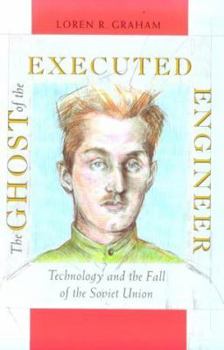The Ghost of the Executed Engineer: Technology and the Fall of the Soviet Union
Select Format
Select Condition 
Book Overview
Stalin ordered his execution, but here Peter Palchinsky has the last word. As if rising from an uneasy grave, Palchinsky's ghost leads us through the miasma of Soviet technology and industry, pointing out the mistakes he condemned in his time, the corruption and collapse he predicted, the ultimate price paid for silencing those who were not afraid to speak out. The story of this visionary engineer's life and work, as Loren Graham relates it, is...
Format:Paperback
Language:English
ISBN:0674354370
ISBN13:9780674354371
Release Date:February 1996
Publisher:Harvard University Press
Length:154 Pages
Weight:0.55 lbs.
Dimensions:0.5" x 6.1" x 9.2"
Customer Reviews
1 rating
Exclude the human element from planning at your peril.
Published by Thriftbooks.com User , 25 years ago
The Soviet Union became the world¹s second largest industrial power, resisted and defeated Hitler¹s armies in World War II, and finally launched the first artificial satellite and first human into Earth orbit. Despite these achievements the Soviet Union collapsed short of the 75th anniversary of the Bolshevik revolution. This small book looks at the Soviet failure from an engineering view, specifically one engineer, Peter Palchinsky. From the beginning of his career in 1905, Palchinsky firmly believed that engineers should consider economic and social conditions along with their technical calculations. Although he was not a Marxist, Palchinsky was a radical who drew many of his social and economic ideas from Kropotkin¹s writings. Palchinsky didn¹t support the Bolsheviks but he did welcome the opportunity to help socialist development in Russia. Palchinsky wanted to keep western capitalists out of Russia as much as possible but he did see that in some circumstances western equipment and knowledge were necessary. The industrialization policy started by the Bolsheviks and carried further by Stalin emphasized gigantic projects controlled directly from Moscow. Some of the characteristics of the soviet projects included no consideration for local conditions, safety sacrificed to output, rushed tempo of the work, and finally no criticism or debate was allowed. Palchinsky did continue criticizing what he considered a disastrous industrialization policy until he was arrested in the middle of the night in 1928 and finally executed in 1929. The author offers three examples of gigantic ill-conceived engineering projects in the early Soviet Union and three projects of the 1970¹s and 80¹s. These projects included world¹s largest steel mill in Magnitogorsk, the world¹s largest hydroelectric dam on the Dneiper River, and finally the disastrous White Sea Canal built entirely by prisoners. Palchinsky was involved with the steel mill project and a sever critic of the other two projects. Chernobyl is given as a latter day example to show that the Soviet Union never learned its lesson. After Palchinsky, engineering training in the Soviet Union became narrower and strictly technical after the 1920¹s. Despite the narrowing of the views of engineering profession in the Soviet Union, engineering training became one of the surest ways of securing government positions. After World War II most Soviet officials came from an engineering background, Brezhnev himself was a graduate of an engineering institute. The lessons of this book go beyond the experience of the Soviet Union. Any political-economic system that centralizes control, stifles debate and criticism, and ignores human conditions may do so at its peril.




